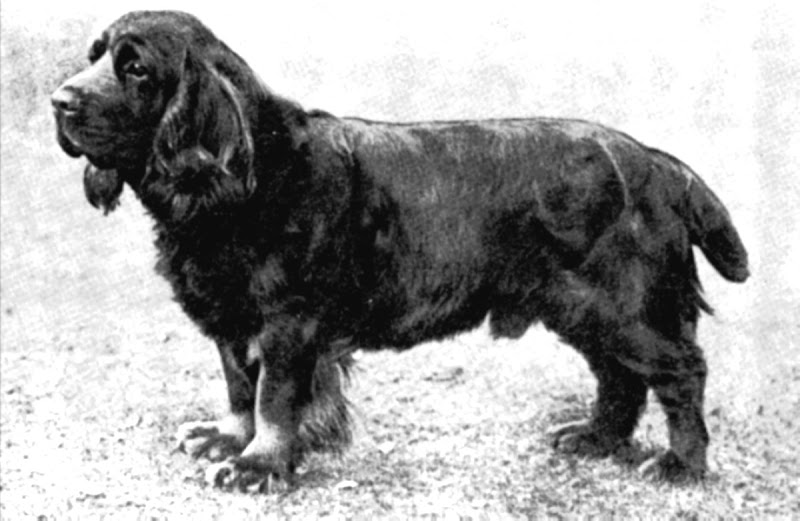This lecture has been developed to show the vast differences between the Clumber and Sussex dog breeds.
Where possible the pictures between the two breeds have been match to illustrate the two breeds to demonstrate this variation
The pictures have been scanned at 300dpi 1200pixels wide so can be slow to come up on the screen but will print out well
On type: pictures have been shown that reflect the British/Aust/NZ/FCI breed standard at the end of the twentieth century
lecture and composite illustrations by Jan E Irving
CLUMBER vs SUSSEX
THEY ARE SO DIFFERENT!
This lecture has been developed to show the vast differences between the Clumber and Sussex dog breeds.
Where possible the pictures between the two breeds have been match to illustrate the two breeds to demonstrate this variation
The pictures have been scanned at 300dpi 1200pixels wide so can be slow to come up on the screen but will print out well
On type: pictures have been shown that reflect the British/Aust/NZ/FCI breed standard at the end of the twentieth century
lecture and composite illustrations by Jan E Irving
 |
 |
the Sussex and Clumber hail from vastly different climates in the British isles – Sussex is on the southern coast and receives more hours of sun, three months less snow, is slightly warmer but has comparable days of rain and amount of rain in the year to Clumber Park, which is in the north of Nottinghamshire in the Sherwood Forest.

Sussex is open farm country, and so well established as agricultural land it boasts at least three very successful breeds of livestock. The terrain is wide open undulating hills, game is restricted to hedgerows and fallow fields

Clumber Park is the product of forest being felled several times for ship timber, consequently it hosts regenerated forest with light canopy and heavy undergrowth. Although fairly flat ground, the forest floor is strewn with large logs. When the house was built the seat was noted for its large rabbit population and sparse of game birds

While Sussex and Clumber Park share pheasants and partridge; Sussex may occasionally host woodcock but these would not be found as far north as Clumber Park, whereas Clumber Park dogs could be expected to face grouse and snipe.
The evolution of all breeds has been a product of their natural terrain and the hunting techniques developed and available.
From 1600 to 1800 the flintlock was used and required the ‘gun’ to walk up on his prey, a flushing dog was not appropriate, hence the evolution of setters and pointers to such a degree in this era. From about 1650 the spaniel was evolved to accompany ‘guns’ on horseback for penetration into heavier undergrowth
Only in 1699 was shooting on the wing possible with the evolution of better guns, from 1799 guns became even easier for the ‘gun’ to carry and use as the barrels were shorter.
In the early 1800s percussion cap guns were sold, in the mid 1800s breech loading guns allowed the ‘sportsman’ to participate in large ‘driven’ shoots where game birds were driven towards the guns by beaters and dogs. At this stage the pheasant was able to be nurtured or even raised by gamekeepers and as a larger bird with a more pleasant taste it was favoured throughout England, so the Retriever and Spaniel breeds rapidly developed
The photos are self explanatory – I suggest you read and digest the breed standard!




While the true work of both the Clumber and Sussex is to flush, they are often expected to retrieve game too; these two photos show a huge difference in styles.
The Clumber is fast and gay with a long clean stride and carries the game well clear of the ground.
The Sussex is dignified and careful carrying its game much closer to the ground but with equal success in completing retrieve without damage to the carcass.

The Clumber works with his nose to the ground, and so streamlined that the heavy undergrowth will slide past his face and eyes, glance over his head, up and not impeding his shoulder, along his ribs and back, not impeding his hind action. On scent the tail is often ‘flagged’ as a pendant at 45 degrees giving the ‘gun’ more opportunity to spot his white dog in heavy undergrowth
The Sussex also skims the ground with his nose, not often penetrating such heavy undergroth, he needless needs the physique and satutre to easier penetrate hedgerows (hawthorns, etc) and fallow stubble
this lecture is copyright Jan E Irving 2003
acknowledgements:
Animals Home Dog (photos Richardson, Fall)
Dogs in Britain (photo Fall)
Rae Furness
Erinveine Clumbers
Felcourt Sussex



